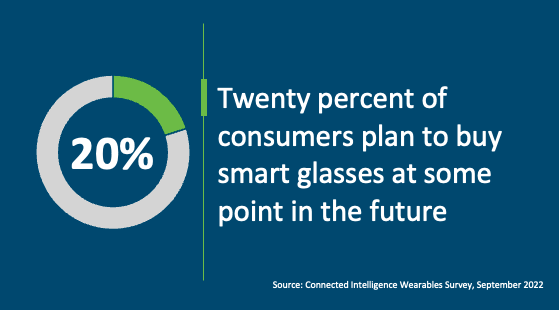
Meta plans for a post-smartphone world
According to a leaked Meta roadmap, the company is working on a long term smart glasses strategy. The strategy sets expectations that by 2027, Meta will launch its most advanced smart glasses, along with a smartwatch that will complement the smart glasses. Rumor has it that the glasses will start with internal employee testing in late 2024. The goal behind this strategy is to plan for a post-smartphone world, where a combination of smart glasses and artist-based wearables will supersede the need for a smartphone.
The NPD Take:
- We believe that Meta is right on the money to be planning for a post-smartphone world. Obviously this will not happen overnight, but the company needs to stake its place in the early market opportunity now. Meta was far too late to the smartphone market, and failed to make a dent with its failed smartphone attempt. This time around, the company is planning ahead with both a watch and glasses strategy if – and it is still an if – the supposedly-leaked strategy plan is accurate and real.
- Reducing features on Fitbit devices is a risky strategy. While many of these changes may not be noticed by current customers (assuming that they do not use these features of course) it creates a perception in the market that the Fitbit brand is being devalued. As a result, it will create some fear and uncertainty among potential customers. This could drive these customers towards the Pixel Watch, but it is just as likely to push them towards alternative brands – including Apple.Our initial expectation of the combination of a watch and glasses is that the watch should provide the cellular connection, thus enabling the glasses to be lighter (i.e., no modem required). Further, while the watch clearly provides a poorer interface to the world compared to glasses, the watch will be an “always-worn” device while the glasses may be optional at certain times of the day for many consumers.
- Our one caveat is that smart glasses still have a long way to go. The models demonstrated at MWC in Barcelona were interesting – and significant advances compared to previous iterations – but still far from being a mass-market solution that can replace a smartphone.
The Garmin touch
Garmin has launched two new running-oriented smartwatches – the Forerunner 265 and 965 – that, crucially, offer AMOLED screens with touch screens. I say crucially because touch screen control is synonymous with “smart phone” for many consumers and the lack of this feature in the Forerunner range was certainly a drawback for many consumers. In fairness to Garmin, the reality was that the previous Forerunner range had a good interface designed around the five-button control, but consumer perception is king. Of course, these watches are certainly premium devices: the Forerunner 265 retails at $449.99 while the 965 retails at $599.99. As such, the market for them is very different than the standard smartwatch market which retails for far less.
- Garmin’s successful sports-focused niche has come under increased pressure with the launch of Apple’s Utra Watch and we suspect that has driven the need for a touch screen, more advanced device.
- The addition of a touch screen, as well as other recent Garmin enhancements such as improved on-device maps, will help the company to defend its market from Apple’s Ultra.
- In many respects, these cuts highlight the key challenge for any smartwatch vendor that has its own, closed, OS, rather than being part of a larger ecosystem, such as Wear OS, that drives a larger number of apps at a far lower overhead cost. Maintaining a strong array of apps in a closed environment is costly, not just in terms of persuading the app vendors onto the platform in the first place, but ensuring a constant flow of upgrades to keep the apps current. This is precisely the challenge that Microsoft faced with its Windows Mobile OS: getting a large and diverse range of apps to remain competitive.
- There is, of course, some valid logic behind creating a cohesive portfolio of Fitbit + Google that results in a strong range of devices from a basic step counter all the way to an advanced smartwatch. The challenge for Google will be in how it gets to that end goal without losing the trust of its customers.
Polar looks to share
Polar has struggled to maintain its connected sports watch position in recent years, with Garmin taking more of the share. But the company is now looking to diversify somewhat, by providing its sports and fitness know-how to other companies. “Powered by Polar” watches from other watch companies use Polar’s activity, health and sports tracking functionality. The first such watch is widely expected to be Casio’s new G-Shock watch – the GBD H2000 – which is expected to keep the G-Shock’s familiar chunky style but with Polar’s fitness tech snuggled inside it.
The NPD Take:
- Polar has struggled to maintain a strong position in the connected sports watch market, and licensing its underlying sports and fitness know-how has the dual benefit of creating a secondary revenue stream while also broadening consumer recognition of the brand as a core fitness provider.
- For third party OEMs, leveraging Polar’s existing algorithms reduces the cost of entry (and ongoing maintenance) for adding a strong suite of sports and fitness tech.